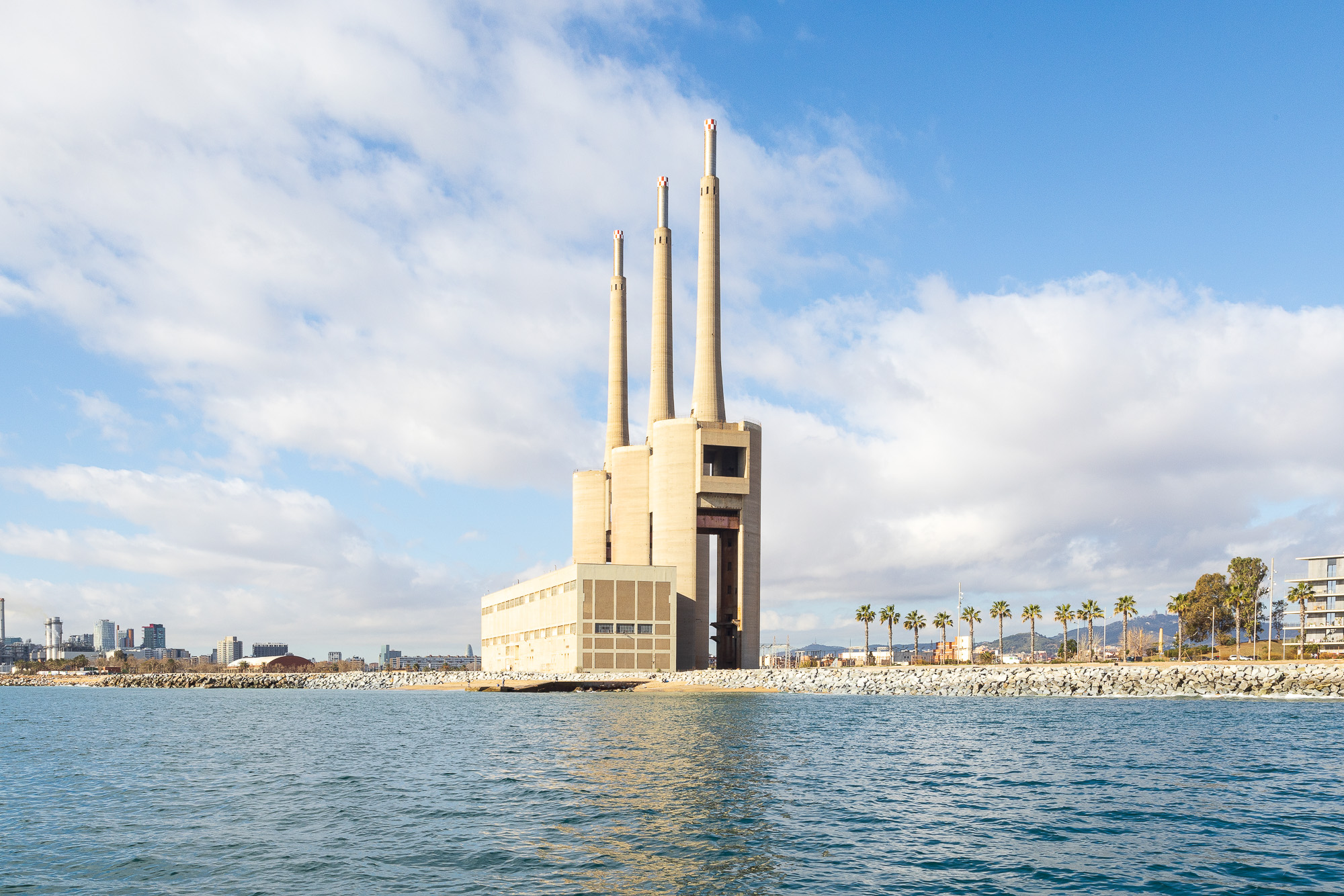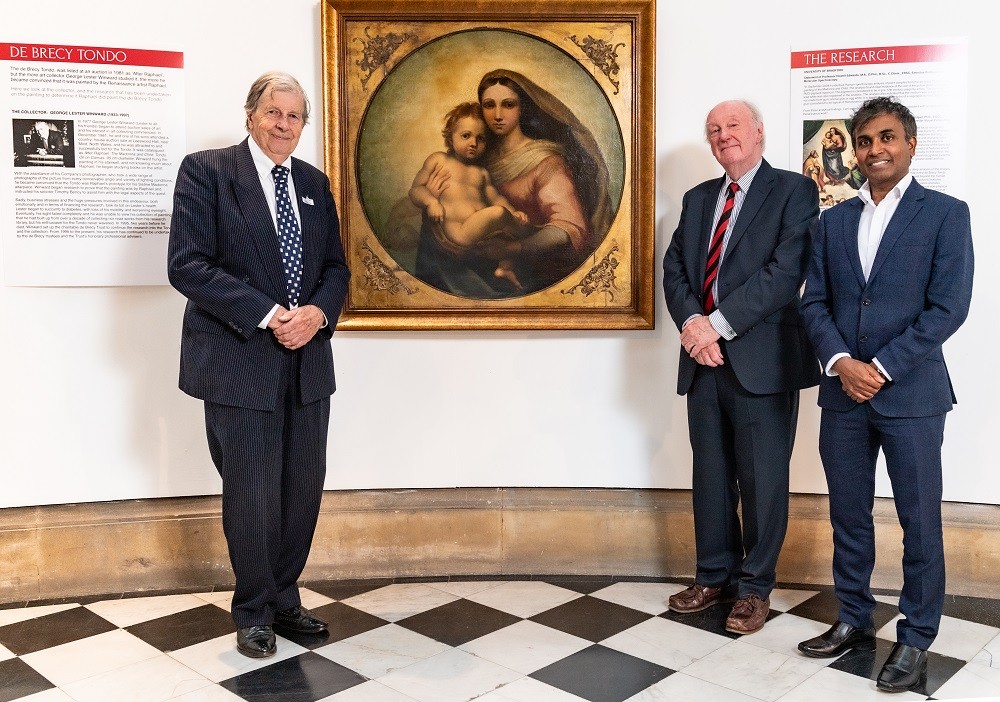As the Catalan capital, Barcelona’s tourism has sparked a crisis for those who live there. Local residents are battling crowds, pollution, and carelessness when it comes to the region’s culture. Despite the municipal government taking measures including banning the construction of new hotels and raising tourist tax, over the summer, tensions culminated in thousands of protestors not only denouncing the city’s over-tourism, but even shooting tourists with water guns out of sheer frustration.
The urgency of this atmosphere underpins the 15th edition of Manifesta, which opened to the public on September 9 (running until November 24, 2024). With an artistic team spread across 12 cities on the periphery of the Spanish city, this edition is intentionally decentralized, focusing on local communities as a methodology for sidestepping the ever-increasing tourism and gentrification of Barcelona itself.
Overseen by Portuguese curator Filipa Oliveira, who is the collective’s creative mediator, this edition takes place around the metropolitan region with a clear ambition: to encourage long-lasting change in the area. Large-scale art events are notorious for paying lip service to such endeavors while often avoiding any meaningful responsibility for enduring transformation. Manifesta 15 seeks to redress this imbalance.
Garden of ‘La Ricarda’, 1965 © Moisès Villèlia. Photo © Manifesta 15 Barcelona Metropolitana. Photo: Ivan Erofeev
Shakespeare’s famous adage, “A rose by any other name would smell as sweet,” could easily apply to Manifesta, which also goes by the European Nomadic Biennale, and has been ever on the move since 1994. (The last edition was in Prishtina, Kosovo, and the next will head to the German region of Ruhr.) Launched to respond to the new social, cultural, and political reality after the Cold War, thirty years on, the project now doubles down, aiming to make socio-ecological improvement its fundamental principle.
A tall order, no doubt. Yet this edition’s will to turn our gaze to the peripheries is, thankfully, non-exhaustive; this show is not about asking everyone to go everywhere. Rather, by embedding itself within atomized local social and ecological infrastructures, the project activates art as a mediating factor to enable both critical engagement and, hopefully, sustained change.
Cue the “clusters:” With three exceptional, if dense, archival presentations mounted at Manifesta 15’s headquarters in Barcelona’s Eixample district—which respectively explore radical pedagogy in 20th Century Catalonia, Barcelona’s democratic and cultural evolution, and Black life in the metropolitan region—the other exhibitions form clusters in spaces as diverse as churches, disused factories, a former panopticon prison, a grain warehouse, and even a bomb shelter. As a whole, this sees 92 artists within three thematic categories: “Cure and Care,” which looks at the healing power of culture; “Balancing Conflicts,” which seeks to protect local natural resources from existential threat; and “Imagining Futures,” which focuses on the Besòs River region, home to one million residents, which has been defined by its disorderly urban growth.
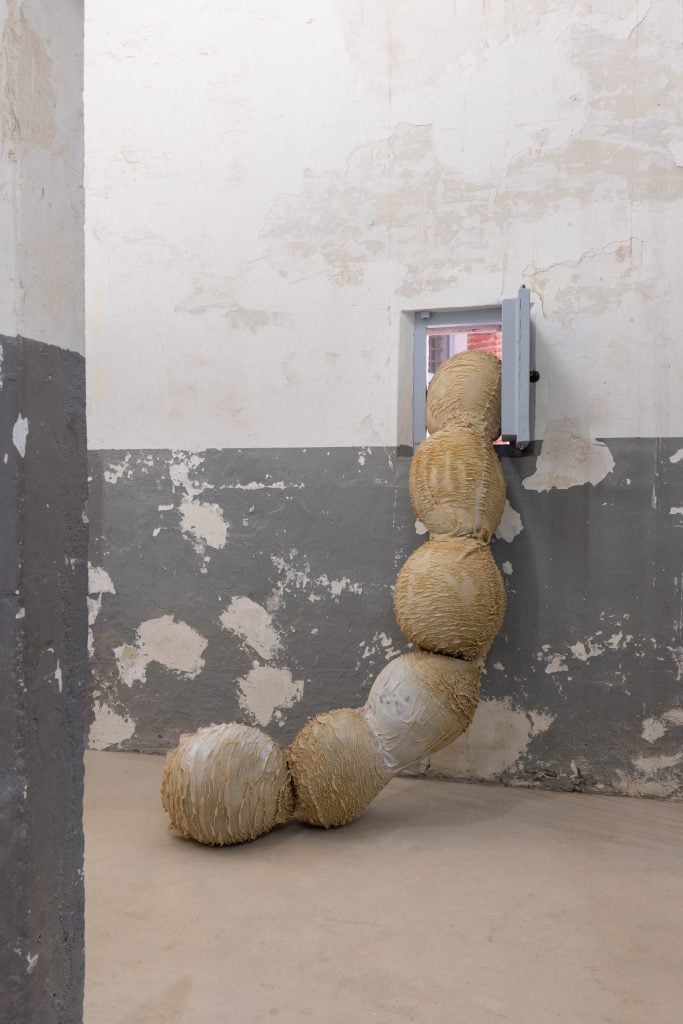
Exudates, 2024 © Eva Fàbregas. Photo © Manifesta 15 Barcelona Metropolitana. Photo: Ivan Erofeev
Cure and Care
The concept of care has become a buzzword in contemporary art circles, with methods of repair often proposed through exhibition making, and usually in ways that are fundamentally different from Western approaches.
At this cluster’s main venue, a 9th-century Benedictine Abbey, an interior courtyard is the definition of peacefulness with its Corinthian columns, trompe l’oeil frescos, and a fountain with bright orange fish. Encountering Simone Fattal’s bronze sculpture Adam and Eve (2021) is an exultant, tongue-in-cheek dig at the iconography of the Christian church, and presumably, when presented in this context, the history of its own questionable approach to care.
These Biblical figures are abstracted into a glorious amalgam of textured flesh, breasts, legs, and torsos weighted with human authority. Upstairs, Dana Awartani’s medicinally-dyed and hand-embroidered silk installation (Let me Mend Your Broken Bones, 2024) sees darned windows of red, yellow, and orange silk perfectly patching the negative space of the arches, while Wu Tsang’s video Girl Talk (2015), which explores how identity structures can be dismantled, has the exultant singing voice of theorist and poet Fred Moten ringing out through the halls.
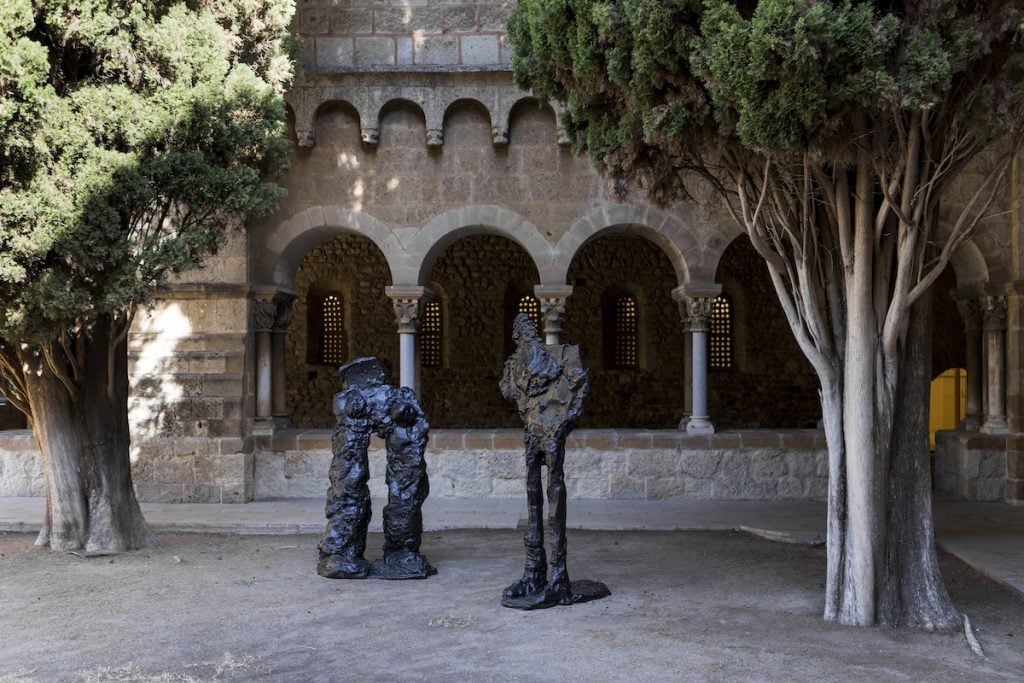
Adam and Eve, (2021) © Simone Fattal. Photo © Manifesta 15 Barcelona Metropolitana. Photo: Cecília Coca
The standout work here is Diana Policarpo’s three-channel video Liquid Transfers (2022–24), a speculative-fiction film about ergot, a fungi growing on wheat that caused hallucinations in humans and shaped social behavior alongside the rise of capitalism. Used by healers, midwives, and experimental military programs alike to “reveal the invisible crimes of our psyche,” it poetically taps into not only the cult of hallucinogenic healing but also into the violent undercurrents of political abuse in the name of care and progress.
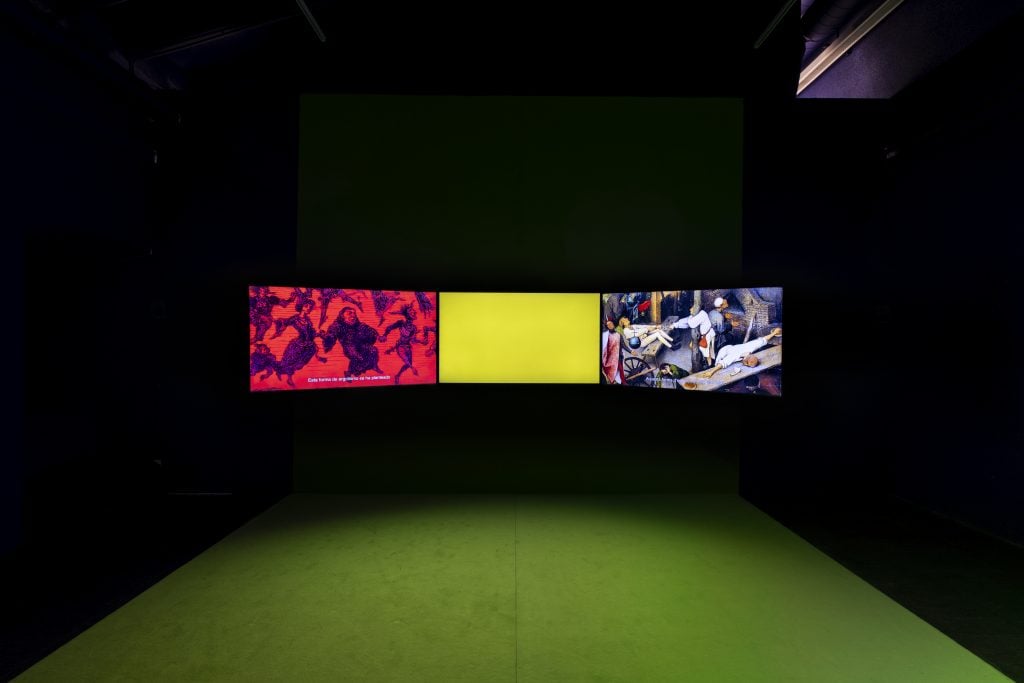
Liquid Transfers, (2022-2024) © Diana Policarpo. Photo © Manifesta 15 Barcelona Metropolitana /
Cecília Coca
At the Museo de Ciencias Naturales (Museum of Natural Sciences), it’s easy to wonder whether aesthetic rigor is sometimes sacrificed for methodology. The glass and textile sculptures of Hugo Canoilas, Sculptured in darkness (2020–24)—bulbous, rock-like forms that merge with the vegetation in the museum’s garden—appear less like the “radical inclusion” of non-human life species in a “post-capitalist world” they’re presented as, and more like incidental leftovers. Similarly, the textile and ceramic works by Tanja Smeets, The Life in Between (2024), which appear as fungi-like growths across a great swathe of two additional venues, a Romanesque church and the textile factory Vapor Buxeda Vell, seem parenthetical and, dare I say, needlessly repetitive and rather decorative.
Infinitely more pertinent as an urgent methodology of cure and care are Lara Schnitger’s colorful patchwork banners, which are draped from the factory’s chimneys: Women’s work is Never Done (2024). As the former “Manchester of Catalonia,” this region was known as the world’s second largest textile industry, which created Catalonia’s wealth. Collaborating with a local women’s sewing association, Xarxa de Dones Cosidores, the installation symbolizes female resilience, building upon the stories of these women and focusing on unrecognized acts of female labor.
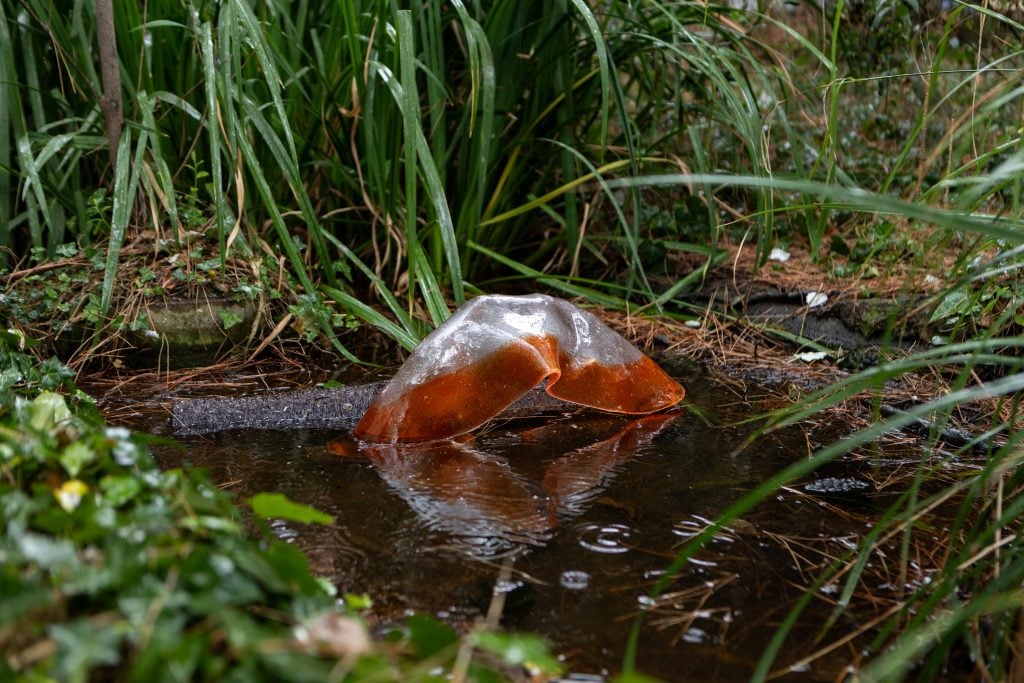
Sculptured in darkness, (2020-2024) © Hugo Canoilas. Photo © Manifesta 15 Barcelona Metropolitana / Cecília Coca
Balancing Conflicts
While some of the venues in this section leave you wondering if you could have just glanced at installation shots online, rather than schlepping for hours to see somewhat mediocre one-work installations, it’s all worth it once you reach Casa Gomis, a private Modernist villa designed by Antoni Bonet i Castellana between 1949 and 1963.
As a former refuge for Catalan’s cultural figures during Franco’s dictatorship, it still functions today as a private home. The villa is bathed in the thick scent of pine, which blends with the heat and rain. It sits in the Llobregat Delta Nature Reserve, bordering Barcelona-El Prat Airport, which is lobbying for an expansion that would destroy both the reserve and the property. This time capsule of Modernist architecture, design, and furniture is one in a million: truly breathtaking, and fighting for survival if indeed the airport is given permission to increase its size.
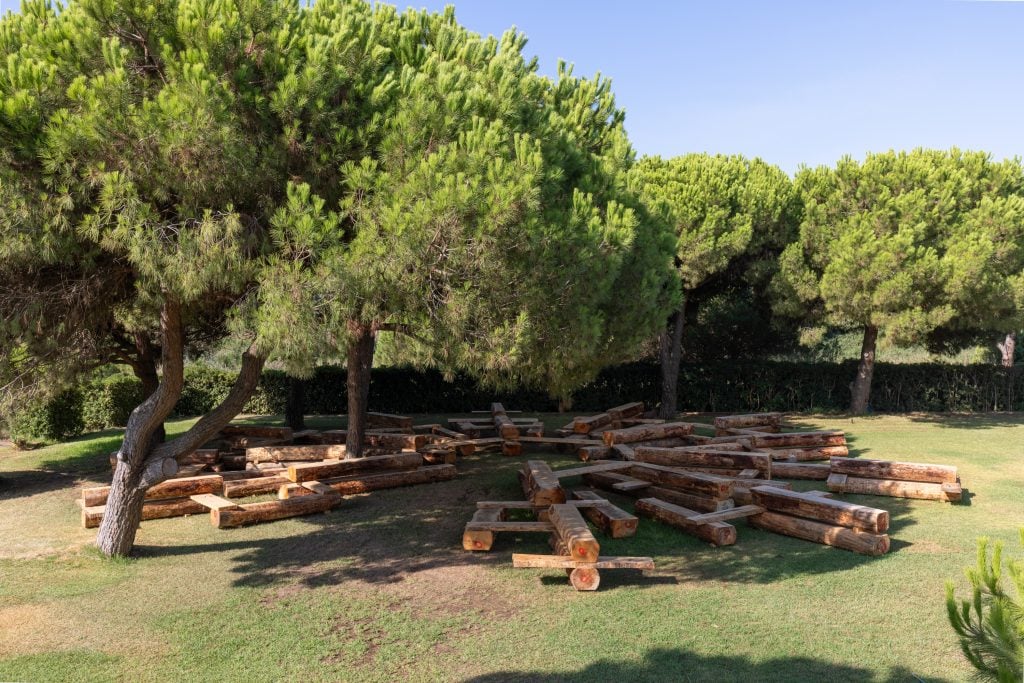
Parliament of Trees, (2022-2024) © Elmo Vermijs. Photo © Manifesta 15. Photo: Ivan Erofeev
Encouraging you to sit beneath a leafy, shaded canopy in the garden, works such as Parliament of Trees (2022–24) by Elmo Vermijs, a layered installation of locally sourced or borrowed timbre, acknowledges trees as being the silent witnesses of climate change, poignantly questioning the fundamental rights of more-than-human entities in our society, which are often voiceless in their struggle for existence.
Inside the villa, another standout moment here is by Catalan artist Magda Bolumar Chertó, whose site-specific painting Xarpellera for La Ricarda (1966) lyrically arranges dots, shapes, and lines like a musical score of joyfully bright primary colors. It was the backdrop for many music performances that took place at the villa against a milieu of political mire. It’s easy to imagine the avant-garde gatherings that flourished here as a means of escaping Franco’s tyranny, even if only momentarily.
Imagining Futures
The absolute standout exhibition at Manifesta 15 is presented at the Tres Xemeneies (Three Chimneys), an utterly colossal thermal power station of concrete and iron built in the 1970s, which generated electricity for the metropolitan region before it was closed in 2011. While the building provided work for the local community, and was therefore termed the “Sagrada Família of the workers,” it too was a source of pollution, environmental damage, and a health hazard: its final closure resulted from its detrimental impact on the climate, causing acid rain.
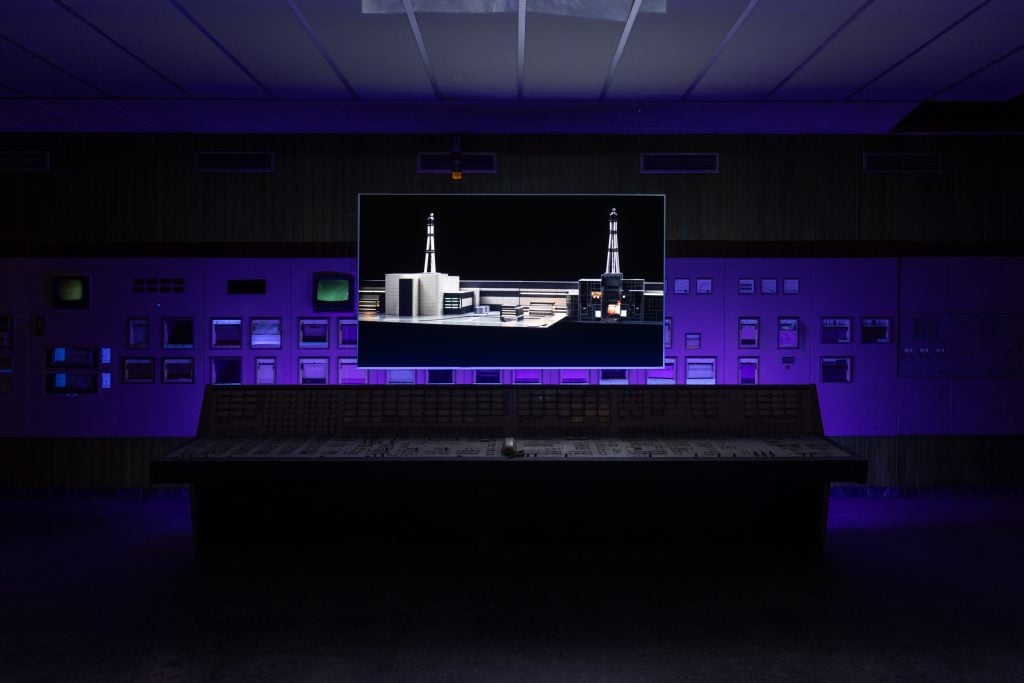
Arrow of Time 2, (2022-2024) © Emilija Škarnulytė. Photo © Manifesta 15 Barcelona Metropolitana. Photo: Ivan Erofeev
At the center of the power station is a powerful archival presentation, Memory of the Smoke, which explores the dual sense of belonging and sustenance brought to the people by Tres Xemeneies, alongside its threatening presence. Photographs, letters, maps, and posters trace the development of the building, from the first demonstrations against the “damned soot” to the residents who fought against Francoism, to the fight for improved labor rights and women’s rights. Manifesta 15 worked together with residents of the Sant Adrià area to create this presentation, which is bursting at the seams with memories, as well as to contemplate the role of this past in paving the way for the region’s future urban transformation.
Another ode to the local residents finds form in the dreamlike outdoor sculpture Urchins (2024), which was initiated by CHOI+SHINE Architects, and was made in La Mina by 120 people living nearby. They wove white threads into lace-like patterns to form two giant spherical structures that appear like immense shells or sea urchins resting near the shoreline. Proximate is Mike Nelson’s Un Intruso (uninvited, into chaos) (2024), a new commission for which the artist built a shack from salvaged materials, with a window that perfectly frames the vast three chimneys slicing into the sky.
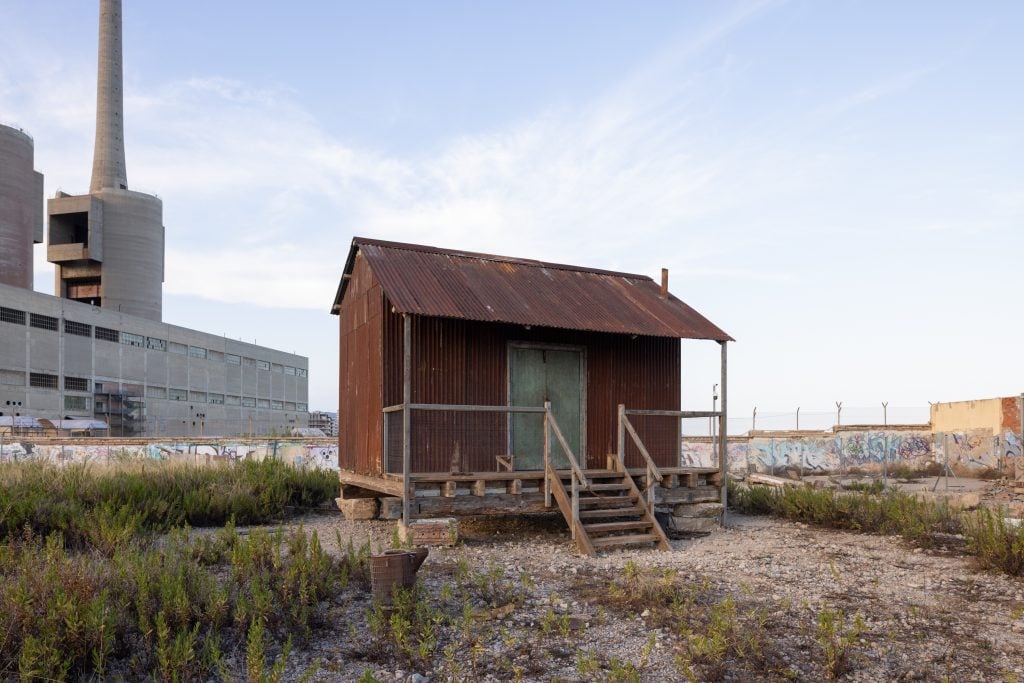
Un Intruso (uninvited, into chaos), (2024) © Mike Nelson, Vegap, Barcelona 2024. Photo © Manifesta 15 Barcelona Metropolitana / Ivan Erofeev
The inclusion of two films are notably well curated: Emilija Škarnulytė’s Arrow of Time 2 (2022–24), which centers on the threat of the Ignalina Nuclear Power Plant in Lithuania when it was under Soviet rule, and Dziga Vertov’s The Eleventh Year (1928), a recently restored propaganda film. It marked the eleventh anniversary of the 1917 October Revolution, celebrating the Soviet Union’s dictatorial empire and engineering might with the construction of the Dnipro Hydropower Station in Ukraine. Both speak to the disastrous proposition that utopia is achievable through industry.
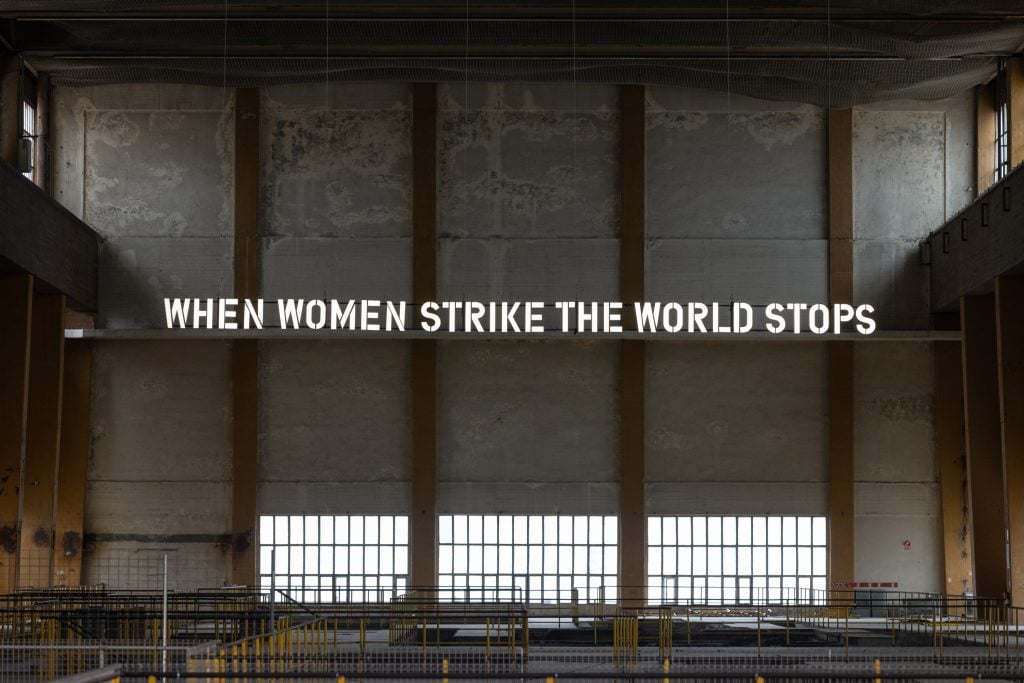
When women strike the world stops, (2020) © Claire Fontaine, Vegap, Barcelona 2024. Photo ©
Manifesta 15 Barcelona Metropolitana. Photo: Ivan Erofeev
It is really the sculptural installations that make this presentation sing, from the acid yellow pigment and hanging pale-pink cocoons of Carlos Bunga’s The Irruption of the Unpredictable (2024), which calls out to the power of renewal, to Diana Scherer’s Yield (2024), a gigantic tapestry made of roots, soil, seeds, and grass that is draped all the way from one factory floor to another, and that references the spines and bones which fascinated Catalan architect Antoni Gaudí.
On the top floor of the Tres Xemeneies, Asad Raza’s Prehension (2024) saw the artist removing three of the factory’s windowpanes to conjure the poetic possibilities of the wind, which blows through the space, activating long drapes of white fabric that rhythmically dance in with air: truly mesmerizing. And perhaps the pièce de résistance is Claire Fontaine’s LED installation When women strike the world stops (2020), which conjures the importance of women to this factory’s history; while only making up 1 percent of the workforce, nonetheless women fought in the shadow of the building for personal rights, environmental safety, and improved living conditions.
Charging art with having the power to activate enduring change—not only to visualize or represent alternative ways of being in the world, but to actively protect and repair–makes Manifesta 15 political by definition. It is a valiant effort, and one that deserves our support while the potential of its long-term influence plays out.
Manifesta 15 runs from the September 8 through November 24, 2024.
Follow Artnet News on Facebook:
